Woke people don’t stereotype, right? And, of course, white men can’t jump. Hm. Consider the following.
For relaxation, my wife Laurel and I attend a bi-weekly creative writing workshop. For a recent assignment, our instructor Jo Scott-Coe asked us to write about chocolate. Each of the other participants wrote about food. Not me. For whatever reason, Jo’s assignment triggered thoughts of former National Basketball Association guard Jason Williams.
A short, scrawny West Virginian, Williams was drafted in 1998 by the NBA Sacramento Kings, where he soon earned the nickname White Chocolate. Why? Because although Williams was White, he played Black. Meaning lots of swag, between-the-legs dribbling, and no-look, behind-the-back passes. According to Wikipedia, Williams became White Chocolate courtesy of a Kings’ media relations assistant named Stephanie Shepard. It stuck because Williams awed competitors and viewers with his crowd-pleasing style, which resulted in lots of spectacular assists as well as lots of unnecessary turnovers.
The fact that writers and announcers felt comfortable referring to Williams as White Chocolate did not come as a great surprise. After all, racial thinking has long inhabited the sports world and racialized metaphors erupt constantly in sports journalism. Particularly when it comes to basketball, racial language is often and openly used to categorize playing styles.
Consider an April 2, 1973, Sports Illustrated article entitled “Boston’s Perpetual Motion Machine.” The article, which focused on Boston Celtic center David Cowens, begins like this.
“A White Center is the pro basketball term for a specific sort of very tall man. He isn’t nimble. He isn’t quick. He can’t jump over a candlestick. Besides, he is likely to be heavy in the rear, slow afoot and better at blocking hats than shots. Over the past 15 years virtually all Caucasian pivotmen have fallen into this category, even though the phrase has lost its racial connotation and has been applied to a few big black men as well.”
“Dave Cowens’ skin is fair, pasty when he relaxes . . . . Cowens is nimble, he is quick, he can jump over candelabra and maybe the moon . . . . 24-year-old Dave Cowens is the first great white Black Center.”
This in-your-face use of racial stereotyping as a metaphor for basketball styles has even made it into movies. No other sport can boast a movie title like the 1992 Wesley Snipes-Woody Harrelson classic, White Men Can’t Jump.
This brings us back to Jason Williams, whose media-hyped visibility overshadowed his less-than-awesome sports achievements. But he did play on the 2006 NBA champion Miami Heat. And included among his admirers are such all-time great African American ballplayers as Shaquille O’Neal, Dwyane Wade, and Isiah Thomas.
Moreover, Williams’ spectacular floor play has given White Chocolate a continuing online presence through oft-replayed video clips. Although he retired in 2011 with modest basketball statistics, there are still internet sites dedicated to White Chocolate’s greatest plays and he still receives attention from sports columnists. For example, a 2020 headline exuded “LeBron James Gets Hyped After Watching Sick Jason Williams Mixtape.” One of the NBA’s most widely-viewed game video clips features Williams passing the ball behind his back with his left hand and then ricocheting it off his right elbow into the hands of a player to his left.
Which brings me to contemporary wokeness. With heightened intergroup sensitivities, concerns about microaggressions, and opposition to ethnic stereotyping, would sport writers still refer categorically to White and Black Centers? Would they still employ racially-stereotypical labels like White Chocolate? And could they still make a movie like White Men Can’t Jump?
True, things have changed. Today people are more wary when talking about diversity. They often avoid using evidence-based group generalizations out of abject terror of being accused of stereotyping. As a diversity consultant, I have to work harder to make the case that it’s O.K. to draw constructively upon cultural generalizations as long as you apply them flexibly and use them with nuance. After all, recognizing group patterns is essential to developing intercultural capacities and addressing such issues as health equity.
So what about the media? Well, in contemporary coverage of the UCLA women’s gymnastics team some writers employ the term “inclusive” in referring to the unique style adopted by some of its African American gymnasts. And they are making a new version of White Men Can’t Jump. Will this be a remake for the woke generation? It will be fascinating to compare the two versions, as it is to compare the 1961 and 2021 film interpretations of West Side Story.
I guess ethnic stereotyping is bad . . . except when it isn’t.
graphic by matthias cooper- unsplash
- Diversity and Speech Part 44: Generations of Gender Talk – by Carlos Cortés - March 1, 2024
- Diversity & Speech Part 43: How 3 College Presidents Flunked Their Speech Midterm Exam– by Carlos Cortés - January 29, 2024
- End of Affirmative Action? A Tale of Two Stories – by Dr. Carlos Cortés - August 8, 2023

